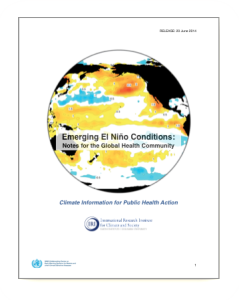El Niño Primer for the Global Health Community
With a moderate El Niño expected to develop later this year, the global health community is closely monitoring seasonal climate forecasts. A new bulletin released by the IRI addresses ways in which health decision-makers can use climate information to reduce the potential for negative health impacts. IRI is a WHO/PAHO Collaborating Centre for Early Warning Systems for Malaria and Other Climate Sensitive Diseases.
El Niño events lead to predictable shifts in temperature and precipitation patterns in certain regions of the globe. This increases the vulnerability of some communities to negative health impacts, especially in developing countries. During the strong 1997-98 El Niño event, severe flooding in Kenya heavily damaged local infrastructure and caused a deadly spike in malaria and other water-borne infectious diseases.
The new bulletin lists several recommendations for improving risk management and disease surveillance in the face of changing climate conditions. Among them is the need for public health officials to partner with national meteorological agencies to improve their understanding of climate forecasts. Closely monitoring monthly changes to ENSO forecasts is also critical for emergency preparedness. If climate experts predict a high likelihood of heavy rainfall, drought, or high temperatures, health authorities are encouraged to develop early contingency plans. Increasing stocks of medical supplies and strengthening coordination with government and humanitarian agencies are key to reducing negative health outcomes should a high-impact climate scenario occur. Download the bulletin to see the full list of recommendations.
Video Resources


You must be logged in to post a comment.